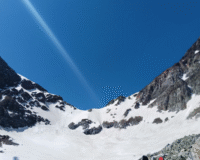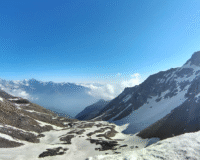Some treks take you to your breaking point. Some alter your mind. And some, like the Rupin Pass Trek, do both—add a dash of magic and mayhem to it. I had come across many blogs calling this one the “most dramatic trek in India,” but no one could have possibly prepared me for what lay ahead. From hanging cliffs to hidden villages and an adrenalin charged pass crossing at near 15,300 feet, Rupin Pass Trek was an epic that I lived one breathtaking step at a time.
Why I Chose the Rupin Pass Trek
I was in dire need of a break. Two years spent immersed in work-from-home life made me crave something wild, uncut, and true. The Rupin Pass Trek appealed to me since it crossed two states—starting in Uttarakhand and ending in Himachal Pradesh—and offered a combination of terrain transitions that most treks could simply not match.
But over the challenge, it was the temptation to trek along hanging valleys, snow bridges, and to stand on a ridge between two large expanses that clinched the deal for me.
Arrival at Dhaula: The Beginning of the Adventure
The trek begins from Dhaula, a serene village in Uttarakhand. The road to there had been a long drive on winding roads, pine scented air, and rolling hills with small houses scattered all over. I arrived there in the evening, and the mountains were on fire as the dusk lowered.
There was a hushed excitement. Our trek leader explained the trail, altitude gradient, and what lay ahead for the next seven days. I barely slept that night—tingling, anxious, and exhilarated all at once.
Day 1: Dhaula to Sewa – Into the Pine Forests
Day one was a cinch—mostly a trek through thick pine forests, rustic wooden bridges, and small villages. The Rupin River was our guide for the entire trek, joining us on the trail.
When we reached Sewa, I viewed the villages’ architecture as nothing I had ever witnessed before. Wooden houses with wood carving inlays, tiny shrines, and smiling locals waving at us as we passed by. This is where I began to feel the warmth of the Himalayas—not necessarily from the sun but from its inhabitants.
Day 2 & 3: Sewa to Jhaka – The Hanging Village
The next two days were where the scenery really started to show its drama. From rolling meadows to knife-backed, serpentine climbs, every hour offered up a new view. Jhaka, the “hanging village,” was itself a wonder—clinging precariously to the side of a mountain, almost defying gravity.
The views here were breathtaking. I remember waking up to clouds passing beneath us and the valley unfolding like an ocean of green. I had already made friends with the other trekkers. Campfire conversations extended beyond friendly chatter, and mountain silence sharpened all perceptions.
Day 4: Jhaka to Upper Rupin Valley – Land of Waterfalls
This was the most beautiful day visually. We hiked through rhododendron forests—some trees still in flower—and into wide alpine meadows. The Rupin Waterfall was visible from a distance now, crashing down with rumbling power.
Reaching the Upper Waterfall Camp was like a dream. The camp was stretched over a vast snow field at the foot of the falls. Snow bridges, ice streams, and cliff walls surrounded us on all sides. I can just sit here and remember being amazed at mother nature’s work of art.
Day 5: The Ronti Gad Climb – The Build-Up
The crossing of the waterfall on a snow bridge was the very first adrenaline experience. Vertical climbing on rocks and ice points with loose rocks where each step mattered was what it was like. The air became thinner and my breathing more strained as we ascended higher.
Ronti Gad was the final base before the pass. More than 13,000 feet up, the cold was biting, but somehow I felt serene. We were high above the world now, and only peaks were surrounding us. The stars were near touchable that night.
Day 6: Rupin Pass Summit Day – A Dream Fulfilled
Summit day dawned in darkness, our headlamps casting back light off the snow. The climb to Rupin Pass was steep and relentless, further exacerbated by strong wind and sub-zero temperatures. But with the morning sun, illuminating the mountain peaks in gold, we pushed on with renewed energy.
And then, finally, here we were perched atop Rupin Pass, 15,300 feet above sea level.
The view? Spectacular. To the left, the valleys of Uttarakhand, and to the right, the Dhauladhar range of Himachal Pradesh towering above. We yelled, hugged, and cried. It was victory and vulnerability, strength and surrender, all at once.
The Himachal side descent was no less thrilling—gliding down the slopes of snow and trekking over glacial terrain until we reached our next camp at Ronti Gad II.
Day 7: Sangla Descent – The Departure
The final day was a long march down to Sangla, a town that felt almost otherworldly after days of isolation. Stepping through apple orchards and streams, my heart was full—grateful for the trek, the pals, and the raw wildness of it.
What Is So Special about the Rupin Pass Trek?
The Rupin Pass Trek is not a path—it’s a drama staged by the Himalayas. It contains every type of landscape in a single journey: dense forests, hung-in-the-air villages, glacial valleys, snowfields, rivers, and high-altitude ridges.
You do not walk in nature—you walk through moods, cultures, altitudes, and angles.
Things I Learned
- Adaptability: The weather kept fluctuating. Sun in one minute, snowing the next. I learned to roll with the punches.
- Minimalism: Having nothing but a backpack to live out of demonstrates how little you really need.
- Connection: Some of the most memorable conversations I’ve ever had were with strangers I met on this adventure.
- Presence: The mountains care nothing for your history or your future. They demand that you be here, now.
Pro Tips for Future Trekkers
- Condition yourself beforehand: Climbing up the pass is tough. Cardio and strength training are beneficial.
- Go with an experienced trekking agency: Safety and experience matter a lot here.
- Pack light, dress in layers: Weather fluctuates heavily.
- Don’t litter, take marked trails, and follow local tradition.
The Journey Within
The Rupin Pass Trek gave me something beyond photographs and ego boosters. It gave me silence, clarity, and awe. It gave me a sense of perspective—how small we are in the grand scheme of things, and how important it is to listen—to nature, to others, and to ourselves.
If ever you get a chance to hike this path, do it. Not just to conquer a trail, but to discover fragments of yourself that only mountains are able to expose.






